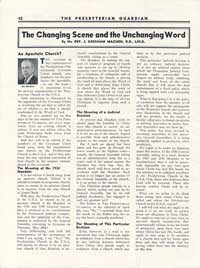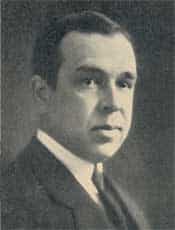This Day in Presbyterian History:
An Historic Commencement Address
Talk about history being made! The first ever commencement address delivered to the student body of Westminster Theological Seminary in Philadelphia, Pennsylvania took place on May 6, 1930. The speaker was the pastor of the First Presbyterian Church of Pittsburgh, Pennsylvania, Clarence Edward Macartney. He was a member of the board of this new seminary, besides being known as a conservative in the issues confronting the Presbyterian Church U.S.A.
 In his address, after looking at the approaching state of the church from the standpoint of its adherence to the Scriptures of the Old and New Testaments, Dr. Macartney focused the attention of the students on the very existence of this new seminary. Listen to his words:
In his address, after looking at the approaching state of the church from the standpoint of its adherence to the Scriptures of the Old and New Testaments, Dr. Macartney focused the attention of the students on the very existence of this new seminary. Listen to his words:
“The founding of Westminster Seminary, therefore, has a peculiar and definite meaning at this critical day in the history of Christianity.
“In the first place, its establishment is a protest against the action of the church in dissolving the Board of Directors of Princeton Seminary, and practically ejecting them for loyalty to the truth.
“In the second place, the establishment of Westminster Seminary is a warning to the Presbyterian Church against the danger of being completely submerged in the tide of neo-Christianity which threatens to engulf the whole Protestant church. This seminary is a watchman on the wall, proclaiming with no uncertain trumpet that an enemy is in our midst.
“In the third place, the establishment of this seminary is a witness to the Bible as the Word of God, a notification to the world that we believe in the Bible, both as to its facts and its doctrines, and are confident that both facts and doctrines are capable of reasoned, thoughtful, and scholarly defense.
“In the fourth place, this Seminary is founded as a witness to the saving power of the glorious gospel of the blessed God and of our Lord Jesus Christ. This Seminary shall stand as a token of our earnest conviction that the gospel of Christ is the alone hope of a lost and fallen race.
“In the fifth place, Westminster Seminary is founded as a token of our faith in the rejuvenescence of evangelical Christianity, and that, as the tops of the mountains were seen after the deluge, so after the deluge and invasion of unbelief in the Protestant church, when the angry waters shall have perished, those sacred heights of mountain tops of Sinai and Calvary shall again be revealed, and the Church shall again bow in gratitude, adoration, and love before the cross of the Eternal Christ.”
After such a reminder of the need for Westminster Seminary to exist, Dr. Macartney then reminded the students that they have been entrusted with the glorious gospel of the blessed God. It was a sacred trust, he added. He spoke about the temptation to forsake that trust, when standing alone, for example, but he encouraged them to resist that temptation and proclaim that blessed gospel.
Words to Live By: Whether we speak about a theological institution, a church, or a Christian, all of us have been entrusted with the gospel. If we won’t defend it, who will? If we won’t utter it, who will? If we forsake it, how will it be carried out? Put in trust with the Gospel — a solemn and sacred treasure to share with the masses.
To read the full message by Dr. Macartney, click here.
Through the Scriptures: Psalms 76 – 78
Through the Standards: Benefits flowing from justification, adoption, and sanctification
WSC 36 — “What are the benefits which in this life do accompany or flow from justification, adoption, and sanctification?
A. The benefits which in this life do accompany or flow from justification, adoption, and sanctification, are, assurance of God’s love, peace of conscience, joy in the Holy Ghost, increase of grace, and perseverance therein to the end.”
Image source : Cover photograph from The Making of a Minister. Great Neck, NY: The Channel Press, 1961.




 William Childs Robinson wrote the lead article, in which he set out four “banners” or defining principles of historic Presbyterianism, principles which had been formerly emulated among Southern Presbyterians. These four banners were loyalty to Christ as King, the Bible as the Word of God written, the Westminster Standards as an expression of sound doctrine, and lastly, the banner of the Great Commission. These were the values that the new magazine espoused as it sought to call the denomination back to faithfulness.
William Childs Robinson wrote the lead article, in which he set out four “banners” or defining principles of historic Presbyterianism, principles which had been formerly emulated among Southern Presbyterians. These four banners were loyalty to Christ as King, the Bible as the Word of God written, the Westminster Standards as an expression of sound doctrine, and lastly, the banner of the Great Commission. These were the values that the new magazine espoused as it sought to call the denomination back to faithfulness.